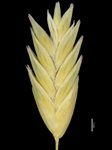
T. longiceps X wiseana spikelet.
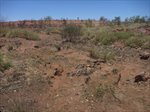
T. longiceps X wiseana habitat.
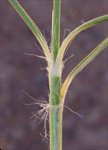
T. longiceps X wiseana orifice.
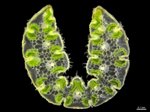
T. longiceps X wiseana leaf section.

T. longiceps X wiseana inflorescence.
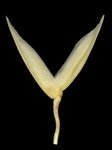
T. longiceps X wiseana glumes.
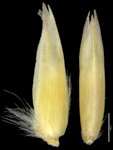
T. longiceps X wiseana lemmas.
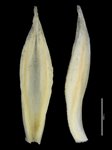
T. longiceps X wiseana paleas.

T. longiceps X wiseana hybrid map.
Name
Triodia longiceps X wiseana
Citation
A rare hybrid, with no formal taxonomic status.
Derivation
For parental species see under Triodia longiceps and T. wiseana. The “X” is a widely used symbol to indicate a hybrid, or cross, between the two indicated species.
Common name
None
Synonyms
None
Diagnostic features
Foliage non-resinous; leaf sheath surfaces glabrous; orifice hairs straight or curved (occasionally becoming tangled when old and dry), 2.0–4.5 mm long, not extending onto the leaf blade; leaf blades amphistomatous (hard-type); lower glume 2.2–6.5 mm long, elliptic, L:W 2–4.4, 3–5-nerved; lemmas shortly lobed, not awned; lemma body uniformly textured, with hairs along the lower midline and margins; lowest lemma midlobe 0.2–0.7 mm long; palea winged, glabrous; distribution rare and scattered in the Pilbara bioregion.
Habitat
Occurs as single plants or small populations on rocky or loam flats, in close proximity to both Triodia longiceps (typically near drainage lines) and T. wiseana (typically) rocky slopes.
Distribution and frequency
Currently known from only two locations in the Pilbara, a single plant on Rocklea Station south-west of Tom Price, and a small population of about 100 plants in an area 50 x 20 m on the Telfer Road in the north-east Pilbara. However since both parental species are widely distributed in the Pilbara, their hybrids potentially occur in extremely low numbers throughout the area
Similar species
Triodia longiceps X wiseana is a hybrid between two species of the Angusta-Wiseana group, the hybrid and both parents all having amphistomatous (hard-type) leaf blades and 1–5-nerved glumes.
Triodia longiceps X wiseana hybrids can be distinguished from T. longiceps by the presence of hairs 2–4.5 mm long at the orifice (T. longiceps lacks hairs, or have only minute hairs <1 mm long at the orifice).
Triodia longiceps X wiseana can be distinguished from most forms (including known co-occurring forms) of T. wiseana by having hairs restricted to the orifice (longer stiff hairs extending onto at least the base of the leaf blade in most T. wiseana). Rare forms of T. wiseana with hairs restricted to the orifice always have prominent lemma lobes 1/3–1/2 of the total lemma length (T. longiceps X wiseana lemma lobes are minutely notched for less than 1 mm).
Triodia longiceps X wiseana is similar to some forms T. angusta with hairs restricted to the orifice, but can be distinguished by having less densely and irregularly arranged spikelets with longest basal pedicels ≥2 mm long (spikelets dense and secund on inflorescence branches, on pedicels to 1.5 mm long in T. angusta).
Triodia brizoides always has woolly hairs at the orifice (±straight in T. longiceps X wiseana).
Conservation status
Not considered a formal taxonomic entity, so has no conservation status.
Identification without florets
The notes under Similar species above cover material lacking florets.
Variation
Hybrids can display an array of characteristics from their parents, especially in second and later generations. The collections included here are probably F1 (first generation) hybrids or early-generation allopolyploid hybrids, so considerably greater variation (e.g. hybrid swarms) than what is recorded might be present in other examples.
Notes
Triodia longiceps X wiseana hybrids were not reported by Lazarides (1997), Lazarides et al. (2005) or Ausgrass (Sharp & Simon, 2002; Simon & Alonso, 2014).
A full description of the hybrid has not been published.
Triodia longiceps X wiseana is not palatable to stock.
Numerous plants at the Telfer Road population have been observed resprouting after fire (MB & BA observations). The plants at this population are discrete, and form a monoculture about 50 x 20 m along a small creek margin, however the method of propagation there is unknown.
The Telfer Road population is an allotetraploid hybrid (with two chromosome copies from each parent), co-occurring with tetraploid T. wiseana and diploid T. longiceps. Ploidy is not known for the single known Rocklea Station hybrid plant. It is possible that hybrids between the quite dissimilar T. longiceps and T. wiseana can only form as allopolyploids, and their formation may be assisted by the presence of co-occurring polyploid forms in at least one parent.